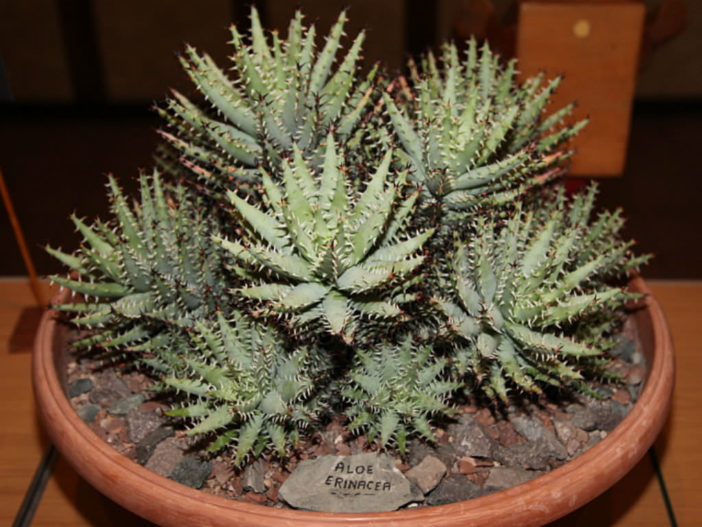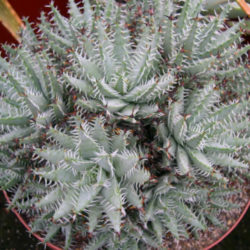Scientific Name
Aloe erinacea D.S.Hardy
Common Name(s)
Locally known as Goree
Synonym(s)
Aloe melanacantha var. erinacea
Scientific Classification
Family: Asphodelaceae
Subfamily: Asphodeloideae
Genus: Aloe
Description
Aloe erinacea, also known as Aloe melanacantha var. erinacea, is a slow-growing succulent that forms rosettes of grey-green or grey-blue leaves with keel and margins armed with hard, sharp, white or black teeth. It usually grows in small compact clumps. Stems are short and inconspicuous, even in old specimens. Leaves are narrowly deltoid, up to 6.4 inches (16 cm) long, and up to 0.4 inches (1 cm) wide. They often have black prickles on the upper surface. The lower surface is obscurely keeled towards the apex. The inflorescence is a subdense raceme with up to 3.3 feet (1 m) long peduncle.
The flowers are tubular, up to 1.2 inches (3 cm) long, and appear in summer. They are crimson in bud but yellowish-orange at flowering. Unfortunately, this species is reluctant to bloom, and the rosette produces flowers only once mature (about 25 years old).
Aloe erinacea looks almost identical to Aloe melanacantha and is sometimes classified as a subspecies or variety of its more common relative. However, it is also considered by many authorities to be simply a closely related sister species of Aloe melanacantha.
Origin
Aloe erinacea is s endemic to southern Namibia. It grows in pockets of sandy soil on rocky outcrops in the part of the Namib Desert with very low winter rainfall.

Hardiness
USDA hardiness zones 8b to 11b: from 15 °F (−9.4 °C) to 50 °F (+10 °C).
How to Grow and Care
Aloe is a very forgiving plant, and a well-grown plant can be quite beautiful. However, as with all succulents, Aloe must never be allowed to sit in stagnant water, and the plant should be carefully monitored to watch for signs of overwatering.
These succulents are not particularly fast-growing and will only rarely need repotting. In the spring, repot Aloes tipping over their pots or have ceased growing. Use a fast-draining potting mix with one-third of sand or pebbles. When repotting a larger plant, it is possible to divide the root ball carefully. Some varieties of Aloe will send off offsets that can be potted independently.
Aloe plants need strong, bright light. They can withstand full summer sun once acclimated. In the winter, provide bright light. It prefers warmer temperatures of 70 to 80 °F (21 to 27 °C) but will survive down to 40 °F (4.5 °C). Feed with a succulent fertilizer in the summer only. Suspend feeding in the winter as the plant goes dormant.
Learn more at How to Grow and Care for Aloe.
Links
- Back to genus Aloe
- Succupedia: Browse succulents by Scientific Name, Common Name, Genus, Family, USDA Hardiness Zone, Origin, or cacti by Genus
Photo Gallery
Click on a photo to see a larger version.



